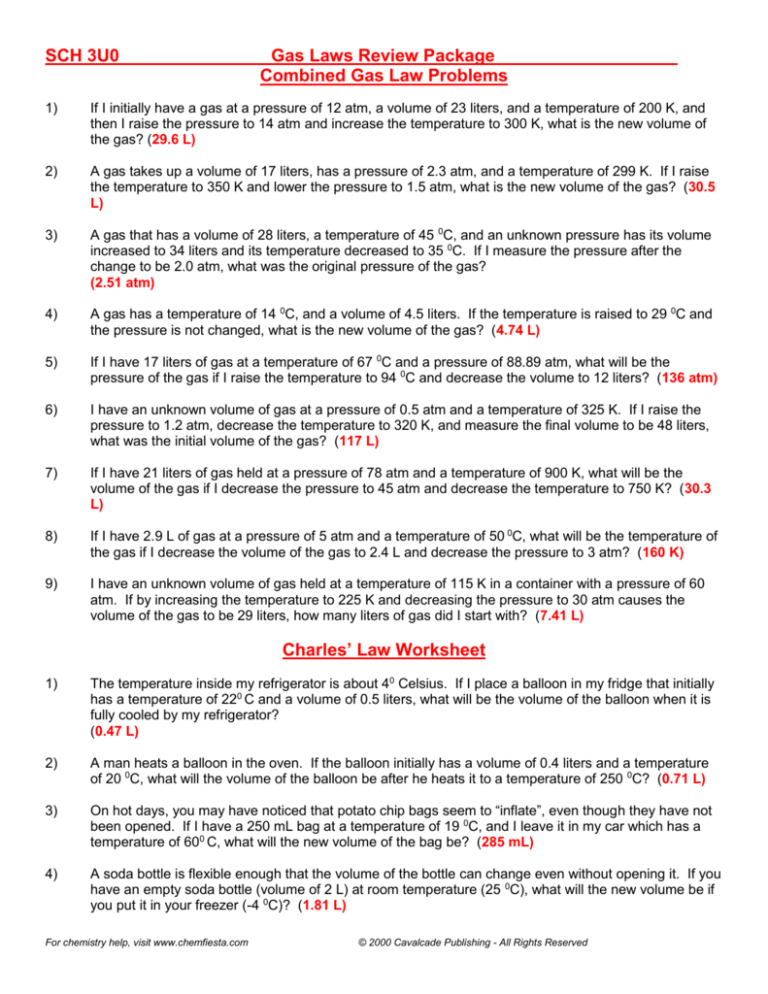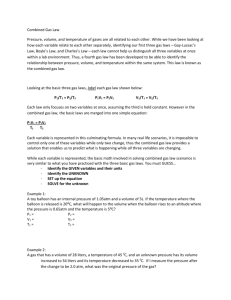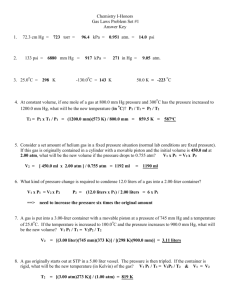
SCH 3U0
Gas Laws Review Package
Combined Gas Law Problems
1)
If I initially have a gas at a pressure of 12 atm, a volume of 23 liters, and a temperature of 200 K, and
then I raise the pressure to 14 atm and increase the temperature to 300 K, what is the new volume of
the gas? (29.6 L)
2)
A gas takes up a volume of 17 liters, has a pressure of 2.3 atm, and a temperature of 299 K. If I raise
the temperature to 350 K and lower the pressure to 1.5 atm, what is the new volume of the gas? (30.5
L)
3)
A gas that has a volume of 28 liters, a temperature of 45 0C, and an unknown pressure has its volume
increased to 34 liters and its temperature decreased to 35 0C. If I measure the pressure after the
change to be 2.0 atm, what was the original pressure of the gas?
(2.51 atm)
4)
A gas has a temperature of 14 0C, and a volume of 4.5 liters. If the temperature is raised to 29 0C and
the pressure is not changed, what is the new volume of the gas? (4.74 L)
5)
If I have 17 liters of gas at a temperature of 67 0C and a pressure of 88.89 atm, what will be the
pressure of the gas if I raise the temperature to 94 0C and decrease the volume to 12 liters? (136 atm)
6)
I have an unknown volume of gas at a pressure of 0.5 atm and a temperature of 325 K. If I raise the
pressure to 1.2 atm, decrease the temperature to 320 K, and measure the final volume to be 48 liters,
what was the initial volume of the gas? (117 L)
7)
If I have 21 liters of gas held at a pressure of 78 atm and a temperature of 900 K, what will be the
volume of the gas if I decrease the pressure to 45 atm and decrease the temperature to 750 K? (30.3
L)
8)
If I have 2.9 L of gas at a pressure of 5 atm and a temperature of 50 0C, what will be the temperature of
the gas if I decrease the volume of the gas to 2.4 L and decrease the pressure to 3 atm? (160 K)
9)
I have an unknown volume of gas held at a temperature of 115 K in a container with a pressure of 60
atm. If by increasing the temperature to 225 K and decreasing the pressure to 30 atm causes the
volume of the gas to be 29 liters, how many liters of gas did I start with? (7.41 L)
Charles’ Law Worksheet
1)
The temperature inside my refrigerator is about 40 Celsius. If I place a balloon in my fridge that initially
has a temperature of 220 C and a volume of 0.5 liters, what will be the volume of the balloon when it is
fully cooled by my refrigerator?
(0.47 L)
2)
A man heats a balloon in the oven. If the balloon initially has a volume of 0.4 liters and a temperature
of 20 0C, what will the volume of the balloon be after he heats it to a temperature of 250 0C? (0.71 L)
3)
On hot days, you may have noticed that potato chip bags seem to “inflate”, even though they have not
been opened. If I have a 250 mL bag at a temperature of 19 0C, and I leave it in my car which has a
temperature of 600 C, what will the new volume of the bag be? (285 mL)
4)
A soda bottle is flexible enough that the volume of the bottle can change even without opening it. If you
have an empty soda bottle (volume of 2 L) at room temperature (25 0C), what will the new volume be if
you put it in your freezer (-4 0C)? (1.81 L)
For chemistry help, visit www.chemfiesta.com
© 2000 Cavalcade Publishing - All Rights Reserved
5)
Some students believe that teachers are full of hot air. If I inhale 2.2 liters of gas at a temperature of
180 C and it heats to a temperature of 380 C in my lungs, what is the new volume of the gas? (2.35 L)
6)
How hot will a 2.3 L balloon have to get to expand to a volume of 400 L? Assume that the initial
temperature of the balloon is 25 0C. (51,800 K)
7)
I have made a thermometer which measures temperature by the compressing and expanding of gas in
a piston. I have measured that at 1000 C the volume of the piston is 20 L. What is the temperature
outside if the piston has a volume of 15 L? What would be appropriate clothing for the weather? (The
temperature is 279.75 K, which corresponds to 6.750 C. A jacket would be appropriate clothing
for this weather.)
Boyles’ Law
Use Boyles’ Law to answer the following questions:
1)
1.00 L of a gas at standard temperature and pressure is compressed to 473 mL. What is the new
pressure of the gas? (2.11 atm)
2)
In a thermonuclear device, the pressure of 0.050 liters of gas within the bomb casing reaches 4.0 x 106
atm. When the bomb casing is destroyed by the explosion, the gas is released into the atmosphere
where it reaches a pressure of 1.00 atm. What is the volume of the gas after the explosion?
(2.0 x 105 L)
3)
Synthetic diamonds can be manufactured at pressures of 6.00 x 104 atm. If we took 2.00 liters of gas
at 1.00 atm and compressed it to a pressure of 6.00 x 104 atm, what would the volume of that gas be?
(3.33 x 105 L)
4)
The highest pressure ever produced in a laboratory setting was about 2.0 x 106 atm. If we have a 1.0 x
10-5 liter sample of a gas at that pressure, then release the pressure until it is equal to 0.275 atm, what
would the new volume of that gas be? (72.7 L)
5)
Atmospheric pressure on the peak of Mt. Everest can be as low as 150 mm Hg, which is why climbers
need to bring oxygen tanks for the last part of the climb. If the climbers carry 10.0 liter tanks with an
internal gas pressure of 3.04 x 104 mm Hg, what will be the volume of the gas when it is released from
the tanks?
(2.0 x 103 L)
6)
Part of the reason that conventional explosives cause so much damage is that their detonation
produces a strong shock wave that can knock things down. While using explosives to knock down a
building, the shock wave can be so strong that 12 liters of gas will reach a pressure of 3.8 x 104 mm
Hg. When the shock wave passes and the gas returns to a pressure of 760 mm Hg, what will the
volume of that gas be? (600 L)
7)
Submarines need to be extremely strong to withstand the extremely high pressure of water pushing
down on them. An experimental research submarine with a volume of 15,000 liters has an internal
pressure of 1.2 atm. If the pressure of the ocean breaks the submarine forming a bubble with a
pressure of 250 atm pushing on it, how big will that bubble be? (72 L)
8)
Divers get “the bends” if they come up too fast because gas in their blood expands, forming bubbles in
their blood. If a diver has 0.05 L of gas in his blood under a pressure of 250 atm, then rises
instantaneously to a depth where his blood has a pressure of 50.0 atm, what will the volume of gas in
his blood be? Do you think this will harm the diver? (V = 0.25 L, yes)
For chemistry help, visit www.chemfiesta.com
© 2000 Cavalcade Publishing - All Rights Reserved
Gas Stoichiometry Practice Sheet
1)
For the reaction 2 H2(g) + O2(g) 2 H2O(g), how many liters of water can be made from 5 L of oxygen
gas and an excess of hydrogen?
(10 L)
2)
How many liters of water can be made from 55 grams of oxygen gas and an excess of hydrogen at
STP?
(77 L)
3)
How many liters of water can be made from 55 grams of oxygen gas and an excess of hydrogen at a
pressure of 12.4 atm and a temperature of 850 C?
(8.15 L)
4)
How many liters of water can be made from 34 grams of oxygen gas and 6.0 grams of hydrogen gas at
STP? What is the limiting reactant for this reaction?
(47.6 L, O2 is the limiting reactant)
The Ideal and Combined Gas Laws
Use your knowledge of the ideal and combined gas laws to solve the following problems. Hint: Figuring out
which equation you need to use is the hard part!
1)
If four moles of a gas at a pressure of 5.4 atmospheres have a volume of 120 liters, what is the
temperature? (1.9 x 103)
2)
If I initially have a gas with a pressure of 84 kPa and a temperature of 350 C and I heat it an additional
230 degrees, what will the new pressure be? Assume the volume of the container is constant.
(146.7 kPa)
3)
My car has an internal volume of 2600 liters. If the sun heats my car from
a temperature of 200
0
C to a temperature of 55 C, what will the pressure Inside my car be? Assume the pressure was
initially 760 mm Hg. (850.8 mm Hg)
4)
How many moles of gas are in my car in problem #3? (108 mol)
5)
A toy balloon filled with air has an internal pressure of 1.25 atm and a volume of 2.50 L. If I take the
balloon to the bottom of the ocean where the pressure is 95 atmospheres, what will the new volume of
the balloon be? How many moles of gas does the balloon hold? (Assume T = 285 K)
(32.9mL, 0.13 mol)
Dalton’s Law Worksheet Answers
1)
A metal tank contains three gases: oxygen, helium, and nitrogen. If the partial pressures of the three
gases in the tank are 35 atm of O2, 5 atm of N2, and 25 atm of He, what is the total pressure inside of
the tank?
(65 atm)
2)
Blast furnaces give off many unpleasant and unhealthy gases. If the total air pressure is 0.99 atm, the
partial pressure of carbon dioxide is 0.05 atm, and the partial pressure of hydrogen sulfide is 0.02 atm,
what is the partial pressure of the remaining air?
(0.92 atm)
3)
If the air from problem 2 contains 22% oxygen, what is the partial pressure of oxygen near a blast
furnace?
(0.92 x 0.22 = 0.20 atm)
For chemistry help, visit www.chemfiesta.com
© 2000 Cavalcade Publishing - All Rights Reserved









